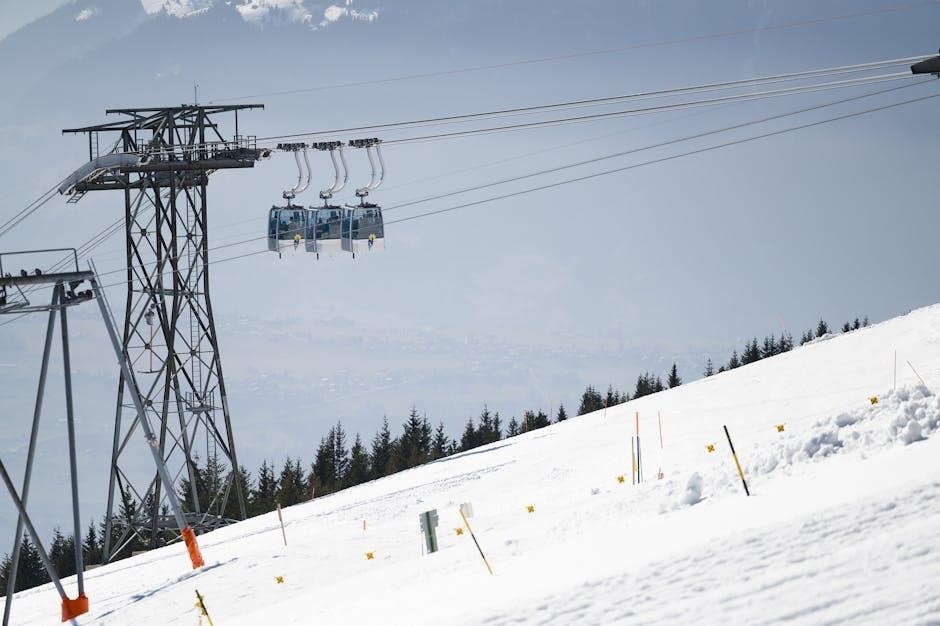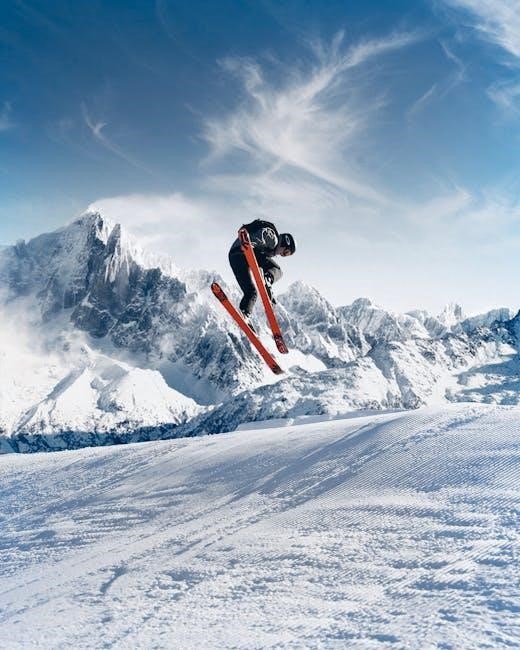Proper ski sizing is essential for optimal performance and enjoyment on the slopes. It considers height, weight, ability, and skiing style to ensure the best fit. Learn how to choose the right skis with our comprehensive guide.
Why Proper Ski Length Matters
Proper ski length ensures optimal control, stability, and maneuverability on the slopes. A ski that’s too short may lack stability at higher speeds, while one that’s too long can be difficult to handle, especially for beginners. The right length enhances performance by allowing precise turns and better edge control. It also improves skiing efficiency, reducing fatigue during long days on the mountain. Incorrect sizing can lead to poor technique and increased risk of accidents. By matching ski length to your height, weight, and ability, you ensure a more enjoyable and safe skiing experience tailored to your needs and skill level.
Overview of Ski Sizing Factors
Ski sizing involves multiple factors, including height, weight, ability level, and skiing style. Height is a primary determinant, with skis typically ranging from chin to head height. Weight influences floatation, particularly for powder skis. Ability level affects the ski’s responsiveness; beginners prefer shorter, more forgiving skis, while experts opt for longer, stiffer ones. Skiing style, such as all-mountain, freeride, or slalom, also plays a role, with each requiring specific lengths and widths. Additionally, gender and terrain preferences can influence size. Understanding these elements ensures a tailored fit, enhancing performance and enjoyment on the slopes. Proper sizing is key to a better skiing experience.

Understanding Ski Length
Ski length is determined by height, weight, and ability, typically ranging from chin to head height for optimal performance and control, ensuring the best experience on the slopes.
General Guidelines for Ski Length
Ski length is determined by a balance of height, weight, and skiing ability. Beginners typically start with shorter skis, around chin height, for easier control and maneuverability. Intermediate skiers often prefer skis reaching the top of their head, offering stability and versatility. Advanced skiers may opt for longer skis, up to forehead height or slightly above, for higher speeds and better float in deep snow. Shorter skis are more agile, while longer skis provide stability and glide. Proper sizing ensures optimal performance, comfort, and enjoyment on the slopes, making it crucial to consider individual factors when selecting ski length.
How to Measure Ski Length
Measuring ski length is straightforward and essential for proper sizing. Stand the skis upright and measure from the tip to the tail using a ruler or measuring tape. Generally, ski length should align with your height and ability level. For most skiers, the skis should reach between the chin and the top of the head when stood upright. Beginners may prefer shorter lengths for easier control, while advanced skiers often opt for longer skis for stability at higher speeds. Use a ski size chart or consult a professional fitter to ensure accurate measurements tailored to your skiing style and preferences.

Why Ski Length Affects Performance
Ski length directly impacts performance by influencing control, stability, and maneuverability. A ski that is too short may lack stability at higher speeds, while one that is too long can be difficult to control. Proper ski length ensures optimal edge hold and turning efficiency, allowing skiers to maintain balance and precision. For beginners, shorter skis are easier to handle, promoting confidence and skill development. Advanced skiers benefit from longer skis for better floatation in deep snow and stability during aggressive carving. Ultimately, the right ski length enhances overall skiing efficiency and enjoyment, making it a critical factor in choosing the perfect skis.

Factors Influencing Ski Size
Ski size is influenced by height, weight, skill level, and skiing style, ensuring the right fit for optimal performance and comfort on the slopes.
Height and Weight Considerations
Height and weight are critical factors in determining ski size. A skier’s height helps establish a baseline for ski length, with taller individuals typically requiring longer skis. Weight also plays a role, as heavier skiers may need stiffer skis for better control. Proper proportions ensure balance and maneuverability, preventing the skis from being too cumbersome or too unstable. By aligning height and weight with the appropriate ski length, skiers can achieve optimal performance and comfort on the slopes. This balance is essential for both beginners and advanced skiers to enjoy their experience fully.
Skiing Ability and Skill Level
Skiing ability significantly influences ski size recommendations. Beginners benefit from shorter skis, as they are easier to maneuver and control, enhancing the learning experience. Intermediate skiers often prefer mid-length skis, offering a balance between stability and agility. Advanced and expert skiers typically opt for longer skis, which provide greater speed and precision, especially in challenging terrain. Skill level dictates the ski’s responsiveness and handling, ensuring that each skier’s needs are met. Tailoring ski length to ability level maximizes performance and ensures a more enjoyable experience on the slopes for all skill levels.
Type of Skiing (All-Mountain, Freeride, Slalom)
Different skiing styles require specific ski lengths. All-mountain skis suit general resort skiing, with lengths tailored for versatility. Freeride skis are longer, offering stability at high speeds and in deep snow. Slalom skis are shorter, enabling quick turns and agility. Adjusting ski length based on the type of skiing ensures optimal performance. All-mountain skiers may prefer mid-length skis, while freeride enthusiasts opt for longer ones. Slalom skiers benefit from shorter lengths for precision. Matching ski length to the skiing type enhances control and enjoyment, making it crucial to consider the primary use when selecting skis.

Ski Sizing Charts
Ski sizing charts provide a structured guide to determine ideal ski lengths based on height, weight, and ability. They simplify the selection process for all skiers.
Adult Ski Size Chart
An adult ski size chart typically ranges from 150cm to 190cm, tailored to height, weight, and ability. Beginners opt for shorter skis, while experts prefer longer ones for stability and speed. The chart aligns height with recommended lengths, adjusting for skill level and skiing style. For instance, a 5’6″ intermediate skier might choose a 160cm all-mountain ski. Weight also plays a role, with heavier skiers needing sturdier, longer skis. The chart serves as a starting point, allowing for personal preference adjustments based on terrain and performance goals.
Children’s Ski Size Chart
Children’s ski size charts are designed to fit young skiers based on height, weight, and skill level. Typically, ski lengths range from 70cm to 140cm. For example, a child measuring 90-120cm tall might use skis between 70-100cm. Beginner kids often start with shorter skis for easier control. As they grow and improve, ski length increases. Weight and ability also influence the choice, with lighter or less experienced kids needing shorter skis. Aligning height with recommended lengths ensures proper fit and performance. Parents should consult these charts and adjust based on the child’s progress and comfort, ensuring a fun and safe skiing experience.
How to Use Ski Size Charts Effectively
Using ski size charts effectively involves aligning your height, weight, and ability level with the recommended ski lengths. Start by measuring your height and weight accurately. Locate your height on the chart and cross-reference it with your weight and skill level to find the ideal ski length range. Consider your skiing style, as charts often differentiate between all-mountain, freeride, and slalom skis. Adjustments may be needed based on personal preference for shorter or longer skis. Avoid common mistakes like ignoring weight proportions or ability level. Use additional tools like ski size calculators for precision, and consult experts if unsure. This ensures a perfect fit for optimal performance and enjoyment on the slopes.

Choosing the Right Ski Length
Choosing the right ski length balances height, weight, ability, and skiing style. Proper sizing enhances control, stability, and performance, ensuring an enjoyable experience for all skill levels.
Beginner’s Guide to Ski Length
For beginners, the ideal ski length typically falls between the chin and the top of the head. This range provides stability and control, making it easier to maneuver. A shorter ski is more forgiving, allowing new skiers to turn and stop with less effort. Height and weight are key factors; aligning the ski length with these measurements ensures a balanced setup. Additionally, considering the skiing style, such as all-mountain or freeride, helps narrow down the optimal length. Using a ski size chart or calculator can further refine the choice, ensuring a comfortable and confidence-building experience on the slopes.
Intermediate and Advanced Ski Lengths
As skiers progress, their ski length can increase for better performance. Intermediate skiers often prefer skis reaching their forehead, offering stability at higher speeds. Advanced skiers may opt for longer skis, up to or slightly above head height, enhancing control in challenging terrain. Ski type plays a role; slalom skis are shorter for quick turns, while freeride skis are longer for float and stability. Weight and ability still influence the choice, but terrain and style become more significant. Consulting a sizing chart or expert ensures the best fit, balancing performance needs with personal preference for optimal skiing experiences.
Adjusting Ski Length for Different Terrain
Terrain plays a significant role in determining the ideal ski length. For powder and backcountry skiing, longer skis (5-10cm above head height) provide better float and stability. On groomed trails, shorter skis (chin to forehead height) allow for quicker turns and agility. In moguls or tight spaces, shorter lengths enhance maneuverability. For racing or high-speed runs, longer skis (forehead to above head) improve stability. Adjusting ski length based on terrain ensures optimal performance and control. Consulting a sizing chart or expert helps tailor the choice to specific conditions, balancing speed, precision, and enjoyment across varying landscapes and skiing styles.

Ski Waist Width and Rocker Profile
Ski waist width and rocker profile significantly impact performance. Waist width affects float and edge hold, while rocker profile influences turn ease and terrain adaptability, enhancing overall skiing dynamics.
Understanding Waist Width
Waist width, measured at the ski’s narrowest point, plays a crucial role in performance. Narrow waist widths (less than 80mm) excel in carved turns on groomed trails, while wider skis (over 100mm) float better in deep snow. Mid-range widths (80-100mm) offer versatility for all-mountain skiing. The choice depends on terrain preferences: narrower for precision, wider for floatation. Proper waist width ensures optimal edge hold and maneuverability, enhancing the skiing experience. Balancing waist width with rocker profile is key for tailored performance across different snow conditions and skiing styles.
Rocker Profile and Its Impact on Ski Performance
Rocker profile refers to the ski’s curvature, influencing how it interacts with the snow. A positive camber provides edge hold and energy return, ideal for groomed terrain. Rocker, or early rise, enhances floatation in powder and ease of turning in deep snow. Skis with a rocker profile in the tip and tail offer better maneuverability and forgiveness. The combination of rocker and camber creates a balanced performance, adapting to various snow conditions. Rocker profiles are tailored to skiing styles, ensuring optimal control and agility. This design innovation has revolutionized skiing, making it accessible and enjoyable across diverse terrain and skill levels. Proper rocker profile selection enhances overall skiing efficiency and enjoyment.

Specialized Skiing Styles
From slalom to freeride, ski styles vary, requiring tailored lengths. Slalom skis are shorter for agility, while freeride skis are longer for stability in deep snow and varied terrain.
Slalom Ski Length Recommendations
Slalom skis are designed for quick turns and agility, typically shorter in length. For adults, slalom skis generally range from 155cm to 165cm, depending on the skier’s height and ability. Beginner skiers may prefer slightly shorter lengths for easier maneuverability, while advanced skiers opt for longer skis to maintain speed. Women’s slalom skis are often shorter than men’s, between 150cm to 160cm. Proper sizing ensures precise control and enhances performance in slalom races and courses.
Giant Slalom and Downhill Ski Lengths
Giant slalom and downhill skis are longer for speed and stability. Giant slalom skis typically range from 180cm to 190cm for adults, while downhill skis can be up to 210cm. Lengths vary based on height, weight, and skill level, with taller skiers needing longer skis. Women’s giant slalom skis are slightly shorter, around 170cm to 185cm. Proper fit ensures edge hold and control at high speeds. These skis are stiffer and designed for experienced skiers, making precise sizing crucial for optimal performance in competitive races and challenging terrain.
Freeride and All-Mountain Ski Lengths
Freeride and all-mountain skis are designed for versatility, balancing stability and maneuverability. Ski length typically falls between chin and forehead height for all-mountain skis, while freeride skis may be slightly longer for better float in deep snow. Lengths generally range from 160cm to 190cm, depending on height and ability. Skiers preferring agility may opt for shorter skis, while those seeking stability often choose longer lengths. Waist width and rocker profile also play a role, with wider skis offering better float and rocker enhancing turn initiation. Proper sizing ensures the ski performs well in various terrains, from groomed trails to backcountry adventures.

Using a Ski Size Calculator
A ski size calculator simplifies choosing the right skis by analyzing height, weight, ability, and skiing style to recommend optimal lengths and widths for a perfect fit.
How Ski Size Calculators Work
Ski size calculators use algorithms to determine optimal ski lengths based on user inputs like height, weight, skill level, and skiing style. These tools analyze data to provide personalized recommendations, ensuring the best fit for performance and comfort. By considering multiple factors, calculators offer a tailored approach to ski sizing, helping skiers of all levels make informed decisions. This method eliminates guesswork, making the selection process efficient and accurate for various skiing needs.
Inputs for Accurate Calculations
To ensure accurate ski size recommendations, calculators require specific inputs, including the skier’s height, weight, skill level, and preferred skiing style. Height and weight help determine the appropriate ski length and flexibility, while skill level (beginner, intermediate, advanced) influences the balance between stability and maneuverability. Skiing style, such as all-mountain, slalom, or freeride, further refines the calculation by accounting for performance needs like speed, agility, or float in powder. Additional factors, such as terrain preferences and gender, may also be considered to tailor the recommendation. Providing detailed and accurate information ensures the calculator delivers the best fit for optimal performance and enjoyment on the slopes.
Interpreting Calculator Results
Once you’ve entered your details into a ski size calculator, it will provide a recommended ski length range. This range is tailored to your height, weight, skill level, and skiing style. The calculator typically offers a minimum and maximum length, allowing you to choose based on personal preference. For example, shorter skis may offer better maneuverability, while longer skis provide stability at higher speeds. Additionally, the calculator may suggest waist width and rocker profile preferences, enhancing performance for your specific needs. Always compare these results with size charts and consider your skiing style to make an informed decision. This ensures a well-rounded and personalized choice.

Common Mistakes to Avoid
- Overlooking ability level when selecting ski length.
- Ignoring weight and height proportions for proper fit.
- Choosing the wrong ski type for your skiing style.
Overlooking Ability Level
One common mistake is ignoring your skiing ability when selecting ski length. Beginners often opt for skis that are too long, making them difficult to control. Intermediate skiers may choose shorter skis, limiting their performance on varied terrain. Advanced skiers might prefer longer skis for stability at higher speeds. Ability level directly impacts how you handle the skis, so it’s crucial to align your skill with the appropriate length. Failing to consider this can lead to poor maneuverability, reduced confidence, and a less enjoyable experience on the slopes. Always tailor your choice to match your skiing proficiency for optimal performance.
Ignoring Weight and Height Proportions
Neglecting to consider weight and height proportions can lead to improper ski sizing. Lighter skiers may find longer skis too cumbersome, while heavier skiers might need more length for stability. Height alone isn’t enough; body mass plays a significant role in how skis perform. A taller, lighter skier might prefer a shorter ski for better agility, whereas a shorter, heavier skier might need a longer ski for control. Ignoring these proportions can result in skis that are either too challenging to maneuver or lack the necessary stability, ultimately affecting performance and enjoyment on the slopes. Always balance height and weight for accurate sizing.
Choosing the Wrong Ski Type
Selecting skis designed for the wrong type of skiing can significantly hinder performance and enjoyment. For instance, freestyle skis are shorter and more flexible, ideal for tricks, while all-mountain skis are sturdier for varied terrain. Choosing a ski meant for a different style leads to poor control and responsiveness. Freeride skis, with their wider waist, excel in deep snow, whereas slalom skis are narrower for speed and agility. Ignoring the intended use of skis can result in difficulty navigating specific conditions, making the skiing experience less enjoyable. Always match your ski type to your primary skiing style and terrain preferences for optimal results.
Proper ski sizing is crucial for optimal performance and enjoyment. Consider height, weight, ability, and skiing style to make the right choice. Use a ski size calculator for accuracy and ensure a perfect fit to enhance your skiing experience. Correct sizing improves control, stability, and overall satisfaction, making every run more enjoyable.
Final Tips for Choosing the Right Skis
When selecting skis, prioritize your skiing style, ability level, and terrain preferences. Use a ski size calculator to narrow down your options, considering height, weight, and gender. Test skis if possible to ensure comfort and performance. Shorter skis offer easier turns, while longer skis provide stability at higher speeds. Adjustments may be needed based on personal preference and skiing goals. Proper sizing enhances control, making your experience more enjoyable and improving overall performance on the slopes. Always refer to a ski size chart for guidance, but trust your feel and skiing style for the final decision.
Importance of Proper Sizing for Enjoyment
Proper ski sizing is crucial for maximizing enjoyment on the slopes. Skis that are too long or too short can hinder performance, reduce control, and lead to fatigue. Correctly sized skis ensure better maneuverability, stability, and responsiveness, making skiing more enjoyable. They also enhance confidence, especially for beginners, by providing a balanced feel. Ill-fitting skis can make turns difficult and increase the risk of accidents, detracting from the overall experience. By selecting the right size, skiers can fully engage with the terrain, enjoy smoother rides, and progress in their skills. Proper sizing is the foundation for a fun and rewarding skiing experience.
